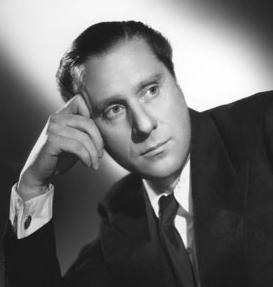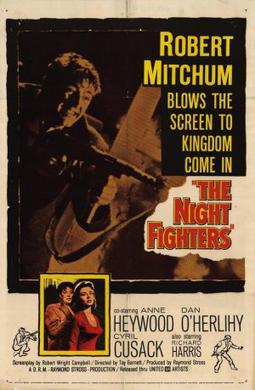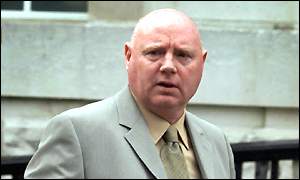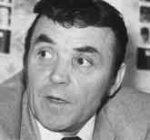
The Informer is a 1935 American drama thriller film directed and produced by John Ford, adapted by Dudley Nichols from the 1925 novel of the same title by Irish novelist Liam O'Flaherty. Set in 1922, the plot concerns the underside of the Irish War of Independence and centers on a disgraced Republican man, played by Victor McLaglen, who anonymously informs on his former comrades and spirals into guilt as his treachery becomes known. Heather Angel, Preston Foster, Margot Grahame, Wallace Ford, Una O'Connor and J. M. Kerrigan co-star. The novel had previously been adapted for a British film of the same name in 1929.

The Ulster Volunteer Force (UVF) is an Ulster loyalist paramilitary group based in Northern Ireland. Formed in 1965, it first emerged in 1966. Its first leader was Gusty Spence, a former Royal Ulster Rifles soldier from Northern Ireland. The group undertook an armed campaign of almost thirty years during The Troubles. It declared a ceasefire in 1994 and officially ended its campaign in 2007, although some of its members have continued to engage in violence and criminal activities. The group is a proscribed organisation and is on the terrorist organisation list of the United Kingdom.

John Adair, better known as Johnny Adair or Mad Dog Adair, is an Ulster loyalist drug dealer and the former leader of the "C Company", 2nd Battalion Shankill Road, West Belfast Brigade of the Ulster Freedom Fighters (UFF). This was a cover name used by the Ulster Defence Association (UDA), a loyalist paramilitary organisation. In 2002 Adair was expelled from the organisation following a violent internal power struggle. Since 2003, he, his family and a number of supporters have been forced to leave Northern Ireland by the mainstream UDA.

Sir Carol Reed was an English film director and producer, best known for Odd Man Out (1947), The Fallen Idol (1948), The Third Man (1949), and Oliver! (1968), for which he was awarded the Academy Award for Best Director.

Cyril James Cusack was an Irish stage and screen actor with a career that spanned more than 70 years. During his lifetime, he was considered one of Ireland’s finest thespians, and was renowned for his interpretations of both classical and contemporary theatre, including Shakespearean roles as a member of the Royal Shakespeare Company, and over 60 productions for the Abbey Theatre, of which he was a lifelong member. In 2020, Cusack was ranked at number 14 on The Irish Times' list of Ireland's greatest film actors.

James Gray, known as Jim Gray, was a Northern Irish loyalist and the East Belfast brigadier of the Ulster Defence Association (UDA), the largest Ulster loyalist paramilitary organisation in Northern Ireland. He was often nicknamed "Doris Day" for his flamboyant clothing, jewellery, and dyed blond hair. Another media nickname for Gray was the "Brigadier of Bling". He was the owner of several bars in East Belfast.

The Shankill Road bombing was carried out by the Provisional Irish Republican Army (IRA) on 23 October 1993 and is one of the most well-known incidents of the Troubles in Northern Ireland. The IRA aimed to assassinate the leadership of the loyalist Ulster Defence Association (UDA), supposedly attending a meeting above Frizzell's fish shop on the Shankill Road, Belfast. Two IRA members disguised as deliverymen entered the shop carrying a bomb, which detonated prematurely. Ten people were killed: one of the IRA bombers, a UDA member and eight Protestant civilians, two of whom were children. More than fifty people were wounded. The targeted office was empty at the time of the bombing, but the IRA had allegedly realised that the tightly packed area below would inevitably cause "collateral damage" of civilian casualties and continued regardless. However, the IRA have denied this saying that they intended to evacuate the civilians before the explosion. It is alleged, and unearthed MI5 documents appear to prove, that British intelligence failed to act on a tip off about the bombing.

The Loughinisland massacre took place on 18 June 1994 in the small village of Loughinisland, County Down, Northern Ireland. Members of the Ulster Volunteer Force (UVF), a loyalist paramilitary group, burst into a pub with assault rifles and fired on the customers, killing six civilians and wounding five. The pub was targeted because it was frequented mainly by Catholics, and was crowded with people watching the Republic of Ireland play against Italy in the 1994 FIFA World Cup. It is thus sometimes called the "World Cup massacre". The UVF claimed the attack was retaliation for the killing of three UVF members by the Irish National Liberation Army (INLA).

Denis O'Dea was an Irish stage and film actor.
Martin McGartland is a former British informer who infiltrated the Provisional Irish Republican Army (IRA) in 1989 to pass information to RUC Special Branch.

A Terrible Beauty is a 1960 drama film directed by Tay Garnett and starring Robert Mitchum, Anne Heywood, Dan O'Herlihy and Richard Harris. It was adapted from a 1958 novel of the same name written by Arthur Roth. The film was an international co-production between Mitchum's production company, D.R.M., and that of producer Raymond Stross.

William "Billy" Stobie was an Ulster Defence Association (UDA) quartermaster and RUC Special Branch informer who was involved in the shootings of student Adam Lambert in 1987 and solicitor Pat Finucane in 1989.

Tommy "Tucker" Lyttle, was a high-ranking Ulster loyalist during the period of religious-political conflict in Northern Ireland known as "the Troubles". A member of the Ulster Defence Association (UDA) – the largest loyalist paramilitary organisation in Northern Ireland – he first held the rank of lieutenant colonel and later was made a brigadier. He served as the UDA's spokesman as well as the leader of the organisation's West Belfast Brigade from 1975 until his arrest and imprisonment in 1990. According to journalists Henry McDonald and Brian Rowan, and the Pat Finucane Centre, he became a Royal Ulster Constabulary (RUC) Special Branch informer.
Alex Kerr is a Northern Irish former loyalist paramilitary. Kerr was a brigadier in the Ulster Defence Association (UDA)'s South Belfast Brigade. He is no longer active in loyalism.
William McFarland, also known as "the Mexican", is a Northern Irish loyalist paramilitary. He was a leading figure in the Ulster Defence Association (UDA), he had served as head of the North Antrim and Londonderry East Tyrone Brigade of the group.
Ken Barrett is a Northern Irish former loyalist paramilitary. A leading figure within the Ulster Defence Association (UDA), Barrett was involved in collusion between loyalists and the British security forces during the Troubles.

On 5 February 1992, there was a mass shooting at the Sean Graham bookmaker's shop on the Lower Ormeau Road in Belfast, Northern Ireland. Members of the Ulster Defence Association (UDA), a loyalist paramilitary group, opened fire on the customers with an assault rifle and handgun, killing five civilians and wounding nine. The shop was in a Catholic and Irish nationalist area and all of the victims were local Catholics. The UDA claimed responsibility using the cover name "Ulster Freedom Fighters", saying the shooting was retaliation for the Teebane bombing, which had been carried out by the Provisional IRA less than three weeks before. A later investigation by the Police Ombudsman found that the Royal Ulster Constabulary (RUC) had engaged in "collusive behaviour" with UDA informers involved in the attack.
Donald Hodgen is a Northern Irish loyalist and a former member of the Ulster Defence Association (UDA). He was best known as the commander and chief enforcer of West Belfast Brigade leader Johnny Adair's notorious C Company which operated on the Shankill Road.
On 14 November 1992, the Ulster Defence Association (UDA), a loyalist paramilitary group, launched an attack on James Murray's bookmakers on the Oldpark Road in Belfast, Northern Ireland. A gunman fired on the customers with an assault rifle, while another threw a grenade inside. Three civilians were killed and thirteen wounded. The shop was in a Catholic and Irish nationalist area, and all of the victims were local Catholics. The attack was likened to the Sean Graham bookmakers' shooting carried out by the UDA earlier that year.

Odd Man Out is a 1945 crime thriller novel by the British writer F. L. Green. The novel is set in present-day Northern Ireland and portrays an IRA heist gone wrong.














